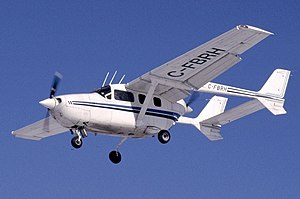Cessna 337
| 336 Skymaster 337 Super Skymaster |
|
|---|---|
 |
|
| A Cessna 337G Skymaster | |
| Role | Personal use and air taxi aircraft |
| Manufacturer |
Cessna Reims Aviation |
| First flight | 1961 |
| Introduction | 1962 |
| Status | Production completed |
| Primary user | Private individuals and organizations |
| Produced | 1963-1982 |
| Number built | 2,993 |
| Variants |
O-2 Skymaster Conroy Stolifter Spectrum SA-550 |
The Cessna Skymaster is a United States twin-engine civil utility aircraft built in a push-pull configuration. Its engines are mounted in the nose and rear of its pod-style fuselage. Twin booms extend aft of the wings to the vertical stabilizers, with the rear engine between them. The horizontal stabilizer is aft of the pusher propeller, mounted between and connecting the two booms. The combined tractor and pusher engines produce centerline thrust and a unique sound. The Cessna O-2 Skymaster is a military version of the Cessna 337 Super Skymaster.
The first Skymaster, Model 336 Skymaster, had fixed landing gear and initially flew on February 28, 1961. It went into production in May 1963 with 195 being produced through mid-1964.
In February 1965, Cessna introduced the Model 337 Super Skymaster. The model was larger, and had more powerful engines, retractable landing gear, and a dorsal air scoop for the rear engine. (The "Super" prefix was subsequently dropped from the name.) In 1966, the turbocharged T337 was introduced, and in 1973, the pressurized P337G entered production.
Cessna built 2993 Skymasters of all variants, including 513 military O-2 versions. Production in America ended in 1982, but was continued by Reims in France, with the FTB337 STOL and the military FTMA Milirole.
The Skymaster handles differently from a conventional twin-engine aircraft, primarily in that if an engine fails, the plane will not yaw toward that engine. Without the issue of differential thrust inherent to conventional (engine-on-wing) twins, engine failure on takeoff will not produce yaw from the runway heading. With no one-engine-out minimum controllable speed (Vmc), in-flight control at any flying speed with an engine inoperative is not as critical as it is with engines on the wing with the associated leverage; however, performance in speed and, particularly, rate of climb are affected. Flying a Skymaster requires a pilot to hold a multiengine rating, although many countries issue a special "centerline thrust rating" for the Skymaster and other similarly configured aircraft.
...
Wikipedia
